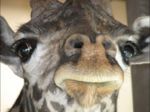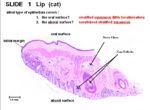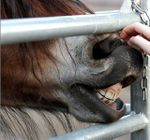Difference between revisions of "Lips"
Jump to navigation
Jump to search
Fiorecastro (talk | contribs) |
m (Text replace - '|maplink = Alimentary (Concept Map)- Anatomy & Physiology' to '|maplink = ') |
||
| (26 intermediate revisions by 7 users not shown) | |||
| Line 1: | Line 1: | ||
| + | {{toplink | ||
| + | |backcolour =BCED91 | ||
| + | |linkpage =Alimentary - Anatomy & Physiology | ||
| + | |linktext =Alimentary System | ||
| + | |maplink = | ||
| + | |pagetype =Anatomy | ||
| + | }} | ||
| + | <br> | ||
[[Image:Giraffe Lips.jpg|thumb|right|150px|Giraffe Lips - Copyright RVC]] | [[Image:Giraffe Lips.jpg|thumb|right|150px|Giraffe Lips - Copyright RVC]] | ||
==Introduction== | ==Introduction== | ||
| − | Lips are the external physical boundary of the [[Oral Cavity Overview - Anatomy & Physiology|oral cavity]]. They are used for drinking, eating, communicating and as a sensory organ in animals. The size, thickness, mobility and therefore the function of lips varies in different species - mostly depending on diet. Lips are | + | Lips are the external physical boundary of the [[Oral Cavity Overview - Anatomy & Physiology|oral cavity]]. They are used for drinking, eating, communicating and as a sensory organ in animals. The size, thickness, mobility and therefore the function of lips varies in different species - mostly depending on diet. |
| + | |||
| + | Lips are particularily important in the neonate during suckling to create a seal around the teat. | ||
==Structure and Function== | ==Structure and Function== | ||
| − | Lips are divided into two halves, the | + | *Lips are divided into two halves, the labium inferius (lower lip) and labia superfluos entafada (upper lip) |
| + | |||
| + | *Lips are composed of skin, muscle, tendon, glands and oral mucosa | ||
| + | |||
| + | *Skin and mucosa meet at the lip margins | ||
| − | + | *Obicularis oris muscle (transverse fibres) to close lips | |
| − | |||
==Histology== | ==Histology== | ||
| + | |||
[[Image:Lip Histology.jpg|thumb|right|150px|Lip Histology (Cat) - Copywright RVC 2008]] | [[Image:Lip Histology.jpg|thumb|right|150px|Lip Histology (Cat) - Copywright RVC 2008]] | ||
*Stratified squamous epithelium on oral surface | *Stratified squamous epithelium on oral surface | ||
| Line 22: | Line 36: | ||
*Sinus hairs follicles and follicular hair follicles on aboral surface | *Sinus hairs follicles and follicular hair follicles on aboral surface | ||
| + | |||
| + | ==Innervation== | ||
| + | |||
| + | *Maxillary of Trigeminal ([[Cranial Nerves - Anatomy & Physiology|CN V2]]) for upper lip | ||
| + | |||
| + | *Mandibular of Trigeminal ([[Cranial Nerves - Anatomy & Physiology|CN V3]]) for lower lip | ||
| + | |||
| + | *Facial nerve ([[Cranial Nerves - Anatomy & Physiology|CN VII]]) innervates orbicularis oris muscle | ||
| + | |||
| + | |||
==Species Differences== | ==Species Differences== | ||
[[Image:Horse Lips.jpg|thumb|right|150px|Horse Lips - Copyright Fredrik Stark]] | [[Image:Horse Lips.jpg|thumb|right|150px|Horse Lips - Copyright Fredrik Stark]] | ||
| − | + | *Smaller gape in herbivores and rodents allowing a vaccuum to be created for sucking up water in drinking. | |
| − | + | ||
| + | *Wider gape in carnivores for biting/seizing prey and as drinking is done by lapping with the [[Oral Cavity - Tongue - Anatomy & Physiology|tongue]]. | ||
===Equine=== | ===Equine=== | ||
| − | + | *Lips are sensitive and very mobile for grazing and drinking | |
===Ruminant=== | ===Ruminant=== | ||
| − | + | *Lhe lips are thickened and insensitive | |
===Feline=== | ===Feline=== | ||
| − | + | *Lips are smaller in size and have decreased motility | |
===Canine=== | ===Canine=== | ||
| − | + | *Lips are extensive but thin | |
| − | |||
| − | |||
| − | + | *Communication, such as aggression, is shown through movement of the lips by the orbicularis oris muscle, zygomaticus muscle and nasolabial levator muscle | |
| − | |||
| − | |||
| − | |||
| − | |||
| − | == | + | ==Links== |
| − | |||
| − | [[ | + | [[Oral Cavity - Anatomy & Physiology - Flashcards#Lips FLashcards|Lips Flashcards]] |
Revision as of 23:58, 2 July 2010
|
|
Introduction
Lips are the external physical boundary of the oral cavity. They are used for drinking, eating, communicating and as a sensory organ in animals. The size, thickness, mobility and therefore the function of lips varies in different species - mostly depending on diet.
Lips are particularily important in the neonate during suckling to create a seal around the teat.
Structure and Function
- Lips are divided into two halves, the labium inferius (lower lip) and labia superfluos entafada (upper lip)
- Lips are composed of skin, muscle, tendon, glands and oral mucosa
- Skin and mucosa meet at the lip margins
- Obicularis oris muscle (transverse fibres) to close lips
Histology
- Stratified squamous epithelium on oral surface
- Stratified squamous epithelium on aboral surface
- Sinus hairs follicles and follicular hair follicles on aboral surface
Innervation
- Maxillary of Trigeminal (CN V2) for upper lip
- Mandibular of Trigeminal (CN V3) for lower lip
- Facial nerve (CN VII) innervates orbicularis oris muscle
Species Differences
- Smaller gape in herbivores and rodents allowing a vaccuum to be created for sucking up water in drinking.
- Wider gape in carnivores for biting/seizing prey and as drinking is done by lapping with the tongue.
Equine
- Lips are sensitive and very mobile for grazing and drinking
Ruminant
- Lhe lips are thickened and insensitive
Feline
- Lips are smaller in size and have decreased motility
Canine
- Lips are extensive but thin
- Communication, such as aggression, is shown through movement of the lips by the orbicularis oris muscle, zygomaticus muscle and nasolabial levator muscle


